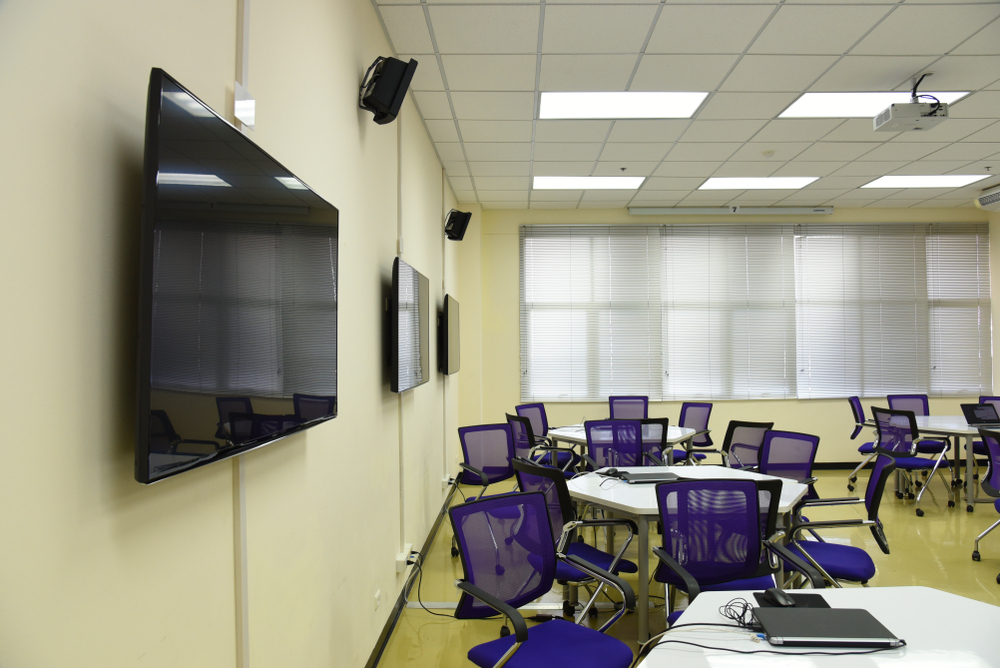In today’s digital age, the integration of audio-visual equipment in educational institutions, such as schools and colleges, has become an essential component of effective teaching and learning. These tools provide educators with dynamic means to engage students, foster comprehension, and enhance overall academic performance. In this exploration, we will delve into the diverse uses of audio-visual equipment in educational settings and examine how it transforms traditional teaching methods.
Interactive Learning
Audio-visual equipment in schools and colleges facilitates interactive learning experiences. Interactive whiteboards, projectors, and touchscreen displays enable educators to engage students in a more dynamic and participatory way. Through these tools, teachers can display educational content, diagrams, and multimedia presentations that students can interact with directly. This hands-on approach enhances comprehension and retention, making complex topics more accessible and engaging.
Visualising Complex Concepts
Visual aids are particularly valuable for explaining complex concepts. With the use of multimedia projectors and 3D models, teachers can illustrate abstract ideas in subjects like science, mathematics, and geography. These visual representations help students grasp difficult concepts more effectively, as they can see how theories are applied in real-life scenarios. This visualisation enhances critical thinking skills and promotes a deeper understanding of the subject matter.
Language Learning
Audio-visual equipment plays a pivotal role in language education. Language labs equipped with headphones, microphones, and video recordings enable students to practice pronunciation and listening comprehension. Multimedia resources like language software, subtitled videos, and interactive language games aid in vocabulary acquisition and grammar comprehension. Additionally, teleconferencing and videoconferencing tools facilitate real-time communication with native speakers, allowing students to develop conversational skills and cultural awareness.
Enhancing Creativity
The integration of audio-visual equipment encourages creativity among students. Video editing software, graphic design tools, and digital cameras empower students to create multimedia presentations, short films, and digital art projects. These creative endeavours not only reinforce subject matter but also cultivate valuable skills such as storytelling, visual communication, and digital literacy. By exploring different mediums, students can express their ideas and viewpoints more effectively.
Distance Learning
Audio-visual equipment is a cornerstone of distance learning programs. With the aid of webcams, microphones, and video conferencing software, educators can conduct live virtual classes, bridging geographical gaps and ensuring access to quality education. Students can participate in discussions, ask questions, and interact with peers and instructors in real-time, mirroring the in-class experience. This flexibility accommodates diverse learning styles and schedules, making education more accessible to a broader audience.
Accessible Education
Audio-visual equipment also plays a crucial role in providing accessible education to students with disabilities. Closed captioning, sign language interpretation, and screen readers make digital content more inclusive. Interactive software and tactile diagrams are designed to cater to students with visual impairments. Hearing-impaired students benefit from amplified sound systems and real-time transcription services. These accommodations ensure that students with disabilities can fully participate in the learning process, creating a more equitable educational environment.
Facilitating Assessment
Audio-visual equipment aids in assessing students’ progress and performance. Educators can record presentations, speeches, or performances for evaluation, offering valuable feedback for improvement. This technology enables the creation of digital portfolios, showcasing students’ achievements over time. Simulations and virtual labs allow for practical assessments in subjects like science and engineering. Additionally, online assessment platforms with multimedia components offer a comprehensive view of students’ understanding and skills.
Professional Development
Educators themselves benefit from audio-visual equipment for professional development. Webinars, online courses, and video tutorials enable teachers and professors to stay updated with the latest teaching methodologies, research, and technology trends. By participating in virtual workshops and conferences, educators can connect with peers globally, fostering collaboration and sharing best practices.
Conclusion
Audio-visual equipment has become an integral part of modern education, enriching the learning experience for both students and educators. It transforms traditional classrooms into dynamic hubs of interactive and immersive learning. From enhancing comprehension to promoting creativity and inclusivity, the uses of audio-visual equipment in schools and colleges are diverse and far-reaching. As technology continues to advance, the role of audio-visual equipment in education will only become more vital in shaping the future of learning.



